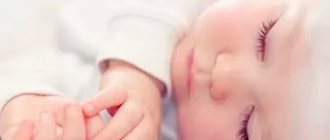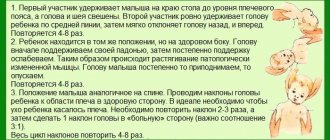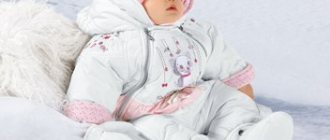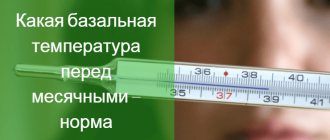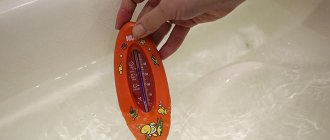From the moment the baby is born, doctors perform many manipulations with it, one of which is measuring the volume of the newborn’s head. This figure can tell pediatricians a lot. In order to prevent the development of certain dangerous diseases in a child in time, parents themselves can determine the size of their child’s head circumference.
Newborn head shape
While passing through the mother’s birth canal, the baby experiences strong pressure on the bones of the skull, which are still soft enough to take the necessary shape and “adapt” to the anatomical features of the mother’s pelvic organs.
When the baby's head drops lower and lower towards the entrance to the pelvis, it can also change its shape somewhat and stretch out so that the baby can be born. As a result, immediately after birth, the baby has an oblong head shape, elongated upward.
Parents should not worry about this feature, as this is quite normal, and after a couple of weeks the head will take on a standard shape.
The skull bones of a newly born baby still retain their mobility - this also should not frighten the young mother, since thanks to this the child avoids injury and does not get stuck in the birth canal.
If the baby was born by caesarean section
In children born through surgery, not only the shape of the head, but also its size, will be somewhat different from babies born naturally.
The period of removal of the baby from the uterus during a cesarean section is about 5-10 minutes, while the baby does not experience pressure (as happens during natural childbirth, when the baby passes through the birth canal). That is why the head of “Caesarean babies” is smooth, has no signs of birth deformation and convex areas at the temples.
The head size of children born as a result of cesarean section will slightly exceed age norms. The pediatrician must take this feature into account when examining the baby in order to draw the correct conclusions about his state of health.
What if there was a caesarean section?
If the baby was born through surgery, his head will be slightly different. It’s not for nothing that doctors say that caesarean babies’ heads are smooth and beautiful, because they didn’t experience any pressure because they didn’t pass through the birth canal. And yet, this is also the norm. Read more about how children develop after cesarean section →
The only thing you need to know is that a child who was surgically removed from the mother’s womb has a slightly larger head circumference and volume than one who was born naturally. The feature can last up to a year. That is why such babies often have a chest narrower than their head. But this does not mean that there was a birth trauma, this is simply the development of caesareans. And to be afraid that your child does not have a big head at all, over time everything will even out.
So, the shape of a newborn’s head should be elongated, uneven, sometimes slightly compressed in the temple area. The baby is not yet able to hold it on his own, so he throws it back, which is also normal in itself. In a newborn who has undergone a cesarean section, the shape of the head is more even, and the volume and circumference may be slightly larger than those shown in the table.
Which indicator is considered incorrect and when should special attention be paid to this aspect of the child’s development?
Why is it necessary to measure the head circumference of children under one year of age every month?
A newborn baby cannot support his head on his own, since the neck muscles are still too weak to support such weight. In the first weeks of his life, the baby will only throw his head back, so it is important to support it when parents or any of the relatives take the baby in their arms.
To train the neck muscles, the child should be placed on his tummy: the baby will try to lift his head from the surface on which he lies, and as the muscles and ligaments strengthen, he will gradually hold it in weight.
By 1 month, children can confidently hold their head up for 10-15 seconds, and by 3 months they can already look around independently. During this period, the volume of the head increases by about 4 cm, and its shape is finally leveled out.
If the child's head circumference is less or more than the established norms, the child needs a thorough examination, as this may indicate serious pathologies and mental retardation.
For the first time, the head circumference of a newborn is measured immediately after birth, after which this indicator should be monitored monthly by the pediatrician and parents for early detection of possible problems and pathologies.
Can heredity affect head size?
Scientists have long proven that a genetic factor can also influence the volume of the head at the time of birth. If mom or dad had non-standard sizes during infancy, but at the same time developed according to age, the likelihood that the child will have slight deviations from normal values is about 23%.
There is no need to worry if the child is not physically and intellectually retarded in development, and the doctor does not see behavioral or other deviations.
How to choose a hat size
It is better to choose a hat together with your child. This way, not only the width of the elastic band is ideally selected, but also the depth of the cap. If you have to decide without a baby or the cap is bought as a gift, use the age indicators from the table. But it is worth considering their averageness. The algorithm of actions in the store is as follows:
- Pay attention to the headgear size markings. The inscriptions on labels in Russia are very easy to read. The size of the hat corresponds to the diameter of the baby's head. For example, at 2 years old the girth is on average 48–49 cm. This means that for a baby you need to buy a size 48 cap.
- Manufacturers of domestic hats sew hats for children according to a step-by-step size chart, deviating from the previous one by 1 cm. That is, size 35 - head diameter 35 cm, 36 cm, 37 cm and so on. It is almost impossible to make a mistake with the choice.
- In rare cases, baby caps are sewn according to the size chart in 2 cm increments. In this case, choose a larger size, especially if the headdress is made of dense, non-stretchy fabric.
- If a knitted or fabric product has a double size: 35–36, then the material stretches well. The cap is suitable for several ages and head sizes.
- It is more difficult to choose hats for winter. You need to carefully approach the height of the forehead and the depth of the headdress. It is better to take such products home to try on or bring your child to the store.
- Lightweight bonnets, scarves, and crocheted spring hats are sold with double markers on the labels separated by fractions. For example, 40/68. The first number indicates the diameter of the head, the second indicates the height of the child. Base your choice on the individual characteristics of the baby. If the toddler is tall, then look at the first indicator; if he is of average height, then consider both.
- You shouldn’t trust labels that only indicate the child’s age. Babies can grow according to an individual plan and are born with heads of different sizes. In six months or a year, the volume ratios can vary by up to 4 cm.
How to find out head circumference: measurement technique
You can measure the circumference of a child’s head at a pediatrician’s appointment or at home yourself, usually using a (soft) centimeter tape.
It is important that the baby is in a calm state and does not cry, otherwise the measurement results may be inaccurate. The ideal time to measure a child is during the daytime nap.
To find out your head circumference, follow these steps:
- wipe the centimeter with a disinfectant solution or antiseptic (for example, Chlorhexidine);
- wrap the ribbon around the child’s head (from the front along the eyebrow line, and from the back along the protrusion at the back of the head);
- Write down the result in a special notepad.
It is advisable to carry out such measurements every month and check them with the table in order to notice in time if something is wrong with the baby.
Physiological norm and deviations from it
So, the usual girth is 35-37 cm, slight fluctuations in both directions are allowed. If the discrepancies are significant, then there may be a lot of reasons for this, and young parents need to know about them.
Birth injury
This is one of the most basic reasons that a newborn's head is abnormal. The consequences may vary, but for the most part they are eliminated by a year or even earlier. Most often, the reason that an injury occurred may be the mother’s incorrect behavior during childbirth, the discrepancy between the sizes of the fetus’s head and the woman’s pelvis, and other features of the process of the birth of a little person. All this can be treated and in itself is not so scary.
Congenital diseases
This is worse than a birth injury. The reason that a baby has a large head may be, for example, hydrocephalus. What it is? This is a very serious disease, often leading to death. However, you shouldn’t be scared right away. The progressive disease is characterized by a very severe course, accompanied by divergence of the sutures of the skull and disorders of not only a physical, but also a mental nature. True hydrocephalus is associated with excess intracranial fluid and is rare.
In addition, if a newborn's head size is significantly smaller than normal, this may indicate microcephaly. And again, there is no need to panic right away. As a rule, the circumference and volume of a baby's head directly depends on hereditary predisposition, and this factor should also be taken into account. True microcephaly is a rather rare disease and is diagnosed at the stage of intrauterine development.
So, the diameter of a child’s head can be influenced by various factors, including not only some diseases, but also trauma that occurred during childbirth. Sometimes a phenomenon called hemangioma can be observed - a benign tumor that looks like an enlarged birthmark. It appears in the first days of a newborn’s life. When parents notice her, they invariably get scared, but again in vain. What harm can come from hemangioma? In principle, none if it is removed in a timely manner.
Table of head circumference for children under one year old
| Child's age | Head circumference, cm | ||||
| Critically low | Low | Norm | High | Critically high | |
| Newborn | 30,3 | 31,5 | 33,9 | 36,2 | 37,4 |
| 1 month | 33,0 | 34,2 | 36,5 | 38,9 | 40,1 |
| 2 months | 34,6 | 35,8 | 38,3 | 40,7 | 41,9 |
| 3 months | 35,8 | 37,1 | 39,5 | 42,0 | 43,3 |
| 4 months | 36,8 | 37,6 | 40,6 | 43,1 | 44,4 |
| 5 months | 37,6 | 38,9 | 41,5 | 44,0 | 45,3 |
| 6 months | 38,3 | 39,6 | 42,2 | 44,8 | 46,1 |
| 7 months | 38,9 | 40,2 | 42,8 | 45,5 | 46,8 |
| 8 months | 39,4 | 40,7 | 43,4 | 46,0 | 47,4 |
| 9 months | 39,8 | 41,2 | 43,8 | 46,5 | 47,8 |
| 10 months | 40,2 | 41,5 | 44,2 | 46,9 | 48,3 |
| 11 months | 40,5 | 41,9 | 44,6 | 47,3 | 48,6 |
| 1 year | 40,8 | 42,2 | 44,9 | 47,6 | 49,0 |
The values presented in the table are approximate and may differ depending on the individual characteristics of a particular child.
Reasons for concern
The table contains only average indicators. Do not forget that each baby has its own rhythm of development. But certain standards by which pediatricians determine deviations still exist.
If the baby’s head begins to actively increase in volume after birth, then this is a clear sign of the formation of hydrocephalus. The pathology is characterized by increased formation of fluid in the spinal canals, which does not have time to be removed from the cavity of the cranium. As a result, the skull begins to grow rapidly.
A small head volume at birth and a lack of further growth of the skull are a symptom of microcephaly (shrinkage of the brain). In some cases, such a pathology in the development of a child can be diagnosed during an ultrasound scan of a pregnant woman. Fetal microcephaly is one of the indicators for termination of pregnancy.
If the child’s head volume is small, a consultation with a neurologist is required, since the baby requires drug treatment.
Possible deviations
The normal head size for a newborn baby ranges from 35 to 37 cm. If deviations from these values exceed 1-1.5 cm, this may indicate serious problems or injury received by the child during childbirth.
Birth injury
Most often, a baby receives a birth injury for the following reasons:
- violation of the behavior technique during childbirth on the part of the mother (for example, when a woman tries to sit during the pushing period);
- malposition;
- discrepancy between the size of the woman’s pelvis and the child’s head circumference.
Birth injuries most often do not pose a life-threatening threat, and their consequences completely disappear when the child is 10-12 months old.
But in some cases, the results can be very sad, so women need to attend all routine examinations with a gynecologist to monitor the baby’s position.
We should not forget about correct behavior at the time of labor - sometimes it is the mother’s actions that lead to tragic abnormalities in the newborn’s cerebral circulation.
Hydrocephalus
This pathology is an accumulation of fluid in the brain space, which puts pressure on the brain and prevents it from growing and developing.
If detected early, hydrocephalus and its consequences can be successfully treated, but in advanced cases, the disease can lead to the death of the child.
Hydrocephalus can be suspected based on the following signs:
- head circumference exceeds the norm by 3-4 cm;
- the fontanelles and frontal bone are enlarged;
- the bones forming the skull diverge slightly;
- a venous pattern appears on the head.
Children with hydrocephalus are restless and often cry. This is due to the fact that the fluid puts pressure on the brain, which causes severe headaches in the child. If such a baby is shown to a pediatric neurologist, other neurological problems can be detected.
Microcephaly
True microcephaly (small brain) is extremely rare. It is impossible to make this diagnosis based solely on the size of the head, since this parameter can be influenced by various factors, including hereditary ones.
If microcephaly is suspected, the baby must undergo an ultrasound scan of the brain. Only after the study can we talk about pathologies.
Hemangioma
This is a benign brain tumor that looks like a birthmark. As a rule, hemangioma appears in the first 7-10 days of a newborn’s life. With timely treatment, the pathology does not pose a threat to life, but the child will require constant monitoring. In addition to the characteristic spot, with this type of tumor there will be an excess of the head circumference above normal values.
What deviations are considered dangerous?
Medical care, including diagnostic measures and a full examination, is required for the baby in cases where the head circumference exceeds (or, conversely, falls short of) the norm by 3-4 cm.
Such indicators almost always indicate severe pathologies for which the child should be placed under the supervision of specialists.
Deviations in brain development are one of the most serious pathologies encountered in pediatric practice.
It is possible to get by with minimal consequences only in cases where the child begins to receive the necessary treatment in a timely manner, so it is important to monitor how the little head grows every month until the child reaches one year of age.
How to measure correctly
A discrepancy between head measurement results and medical standards may indicate disturbances in the development of the skull. This symptom is often a consequence of a serious illness or becomes its direct cause.
Pathologies of this kind include the following:
- Rickets;
- High intracranial pressure;
- Hydrocephalus;
- Microcephaly;
- Craniostenosis.
Head size alone is not enough to make an accurate diagnosis. In such cases, it is necessary to undergo a full comprehensive examination, including tests, consultation with a neurologist, etc.
Therefore, if parents discover that the data obtained does not comply with medical standards, they should not panic. Each child develops individually according to his own schedule, and therefore the rate of growth in each individual case may vary. The established figures are only the basis from which the doctor starts.
Signs of rickets
Important to remember! The indicators for premature infants are different, since the development of the body to a certain extent lags behind the normal growth of full-term children.
The following signs are cause for concern for parents and doctors:
- The child's head is too large and his forehead protrudes forward. The veins are clearly visible - their outlines stand out significantly, the baby’s fontanel is convex. The listed symptoms may indicate hydrocephalus. To establish the truth, a number of tests and examinations (ultrasound, MRI) will be required. It is also necessary to measure the amount of fluid inside the skull.
Hydrocephalus can occur in premature infants; children with intrauterine hypoxia and babies who have experienced a state of asphyxia are also susceptible to this condition. The result is an increase in head size. With this disease, the size of the skull is equal to or greater than the volume of the chest. Children with this diagnosis are seen by a neurologist.
The doctor prescribes medications to improve GM nutrition, as well as diuretics. Children also receive a general massage. The completed course of treatment completely eliminates the problem, and the babies develop normally without any negative consequences. However, if the situation is neglected, the sick baby will lag behind in mental development, will learn to walk, talk, etc. late.
- The skull is small, underdeveloped, the forehead is low, small. These signs are accompanied by neurological disorders. The child also experiences premature closure of the fontanelles. In this case, there is reason to suspect microcephaly in the newborn.
- A decrease in size is also observed with chronic intrauterine fetal hypoxia (lack of oxygen supplied through the placenta during gestation) and chronic nicotine intoxication (occurs if the mother smoked too much during pregnancy). The extreme degree of such conditions is expressed in the form of anencefolia - the absence of the head. This phenomenon is a consequence of genetic disorders or viral diseases, such as chicken pox and rubella, suffered by the mother during pregnancy. To identify pathology in a timely manner, it is necessary to perform an ultrasound of the fetus in the early stages of gestation.
- Often, a decrease in the size of the skull is observed with genetic pathologies. Associated symptoms are often other birth defects:
- Wolf Sky;
- Cleft lip;
- Fused fingers or toes;
- Having extra fingers or toes.
In this case, observation by a geneticist is required. Treatment is aimed at eliminating the identified abnormalities (if possible).
- An increase in the size of the skull can occur in the event of endocrine disorders in the mother’s body (for example, with hyperthyroidism or diabetes mellitus).
Interesting. The size of the baby’s skull is too large and does not allow childbirth to take place naturally, since the baby’s head cannot pass through the birth canal. In such cases, a caesarean section is performed.
Hydrocephalus in a newborn
During the first year of life, the growth and development of a child occurs very intensively - along with the indicators of height, weight, chest volume, the size of the baby’s skull also rapidly increases. Over the course of 6 months, the diameter of the head grows by an average of 1.5 cm every 30 days. Over the next six months, this parameter increases by half a centimeter every month.
Important! In order to identify developmental pathologies, the doctor must take into account not only the diameter of the skull, but also the volume of the child’s chest. In the presence of diseases, the rate of growth of head circumference can significantly exceed the intensity of increase in breast volume or, conversely, greatly lag behind it.
During the first year of life, a baby's head grows quite quickly. Every month, the pediatrician should examine the baby and, in addition to the skull circumference, check the chest volume, height and weight of the newborn for compliance with medical standards depending on age. The head is measured using a measuring tape.
You can find out the size of a baby’s skull at home. This is done in the same way as at a doctor’s appointment - using a tape measure. When taking measurements, the tape is applied to the widest parts of the head: in front at a level just above the eyebrows and at the back along the convex part of the back of the head.
The procedure includes the following steps:
- First you need to prepare a centimeter.
- Place the baby on a table or bed (if the baby has reached six months of age, he can be in a sitting position).
- The tape should be applied to the back of the head so that it passes over the ears through the widest part of the back of the head.
- The starting point of the centimeter is connected to the ending point. The intersection point should be above the eyebrows.
- The result obtained is recorded.
- The data is compared with the norm.
The following recommendations will help you get more accurate results:
- To measure your head circumference, you need to use the same tape every month;
- You should not squeeze the baby’s head, since the bones of a newborn are quite fragile;
- If during the procedure the baby is capricious and cries, it is better to postpone the attempt for now and repeat it a little later;
- Record data without rounding to the nearest millimeter;
- It is better to have a special notebook where measurement data will be recorded every month.
Measuring the diameter of a newborn's head
In order to determine whether the results comply with medical standards, you can compare the data with figures obtained from the following calculations:
- For children aged 1 to 6 months: 43 cm – 1.5 cm;
- For children over six months old: 43 cm 0.5 cm.
Subtraction or addition is done taking into account the number of months that make up the baby’s age. Example for a 3-month-old baby: to calculate the desired parameter, you need to subtract 1.5 cm 3 times from 43 cm. The result will be 38.5 cm. In the same way, you can calculate the diameter of a baby’s head at any age up to one year.
On a note. This calculation is approximate. You can find out which parameters are the most correct using skull circumference growth tables.
It is better to buy a headdress together with the child - by trying on the clothes, parents will be able to choose the correct width and depth of the product. But it’s not always possible to take your baby with you to the store. In such cases, you should be guided by the age parameters from the table and correlate them with the markings on the cap.
Actions when choosing a headdress should be as follows:
- Pay attention to the product label. The size of the item indicated there corresponds to the diameter of the baby's head.
- Domestic manufacturers make hats according to a standard size grid, each value in which differs from the previous one by 1 cm (in rare cases by 2 cm, then you need to choose a larger one).
- If the label says double size, it means the fabric has good stretch. This option is universal and suitable for several ages.
- Lightweight products are double marked in the form of a fraction, the first digit of which indicates the diameter of the head, and the second - the height of the baby.
- To correctly interpret the markings of foreign products, you need to study the corresponding size table.
On a note. If someone in the family knits, then you need to make a hat with knitting needles in accordance with the recently taken measurements. If the process takes more than a month, then you need to add a couple more centimeters to the length and width of the product.
The size of a child’s head by age is the most important indicator of normal growth and development of the baby. If there are deviations from the norm, it is recommended to show the baby to a doctor.
Children under one year of age should have their head circumference measured regularly: once a month. Take measurements correctly like this:
- Take a measuring tape (tailor's tape).
- They place the newborn toddler on the table or put the 6-month-old baby on a high chair.
- Place the tape on the back of the head so that it passes over the ears, through the occipital protuberance.
- Connect the starting point of the tape (0 cm) and the end point above the eyebrow arches.
- Compare the obtained data with the norms.
To get the correct result, use the following recommendations:
- Determine the head diameter using the same tape every month. This way you will eliminate errors.
- Do not put pressure on the baby's head, especially during infancy. An infant's bones are fragile.
- If the baby cries or squirms, try again a little later.
- Record measurement results without rounding (to the nearest mm).
- Keep a diary where you will enter your baby’s anthropometric data every month.
| Manufacturer/Child's head diameter | USA | France | England | Marking in Latin letters |
| 47 | 5 7/8 | 0 | 5 | — |
| 49 | 6 1/8 | 1 | 6 | S/M |
| 51 | 6 | 2 | 6 1/4 | XXS |
| 53 | 6 5/8 | 3 | 6 1/2 | XS |
| 55 | 7 | 4 | 6 3/4 | S |
| 57 | 8 | 5 | 7 | M |
Physiological characteristics of a newborn baby
In recent years, premature babies have appeared in maternity hospitals with a body weight that exceeds the norm for this age. In this case, doctors write that the baby is premature, for example, the gestation period is 36 weeks, “large for the gestational age.” That is, a situation is possible when a child was born weighing 3,200 grams at a gestational age of 35-36 weeks. This is not a positive thing. After all, as a rule, “excess” fetal weight in a newborn baby is gained due to edema. Adaptation of a newborn child with “excess” weight (fetal weight above the table norm) is very often difficult.
Interesting: How to Read an Ovulation Test Second Stripe Bright
Head and symptoms
The spots that you can notice on the baby’s head look like birthmarks, but gradually disappear. They say that strong pressure was applied to the baby's head in this place. Most likely, the baby will cope with the problem on his own, however, the coincidence of a spot in a certain part of the head and some clinical symptoms may indicate that it is worth contacting an osteopathic doctor, since the baby needs help.
Neck injuries are usually accompanied by the following symptoms:
- sucking disorder. Despite the fact that the baby is correctly applied to the breast, he cannot latch on normally or is uncomfortable sucking;
- profuse and frequent regurgitation;
- with severe lesions, problems with speech and vision, torticollis and descending scoliosis may occur in the future.
Damage to the sphenoid bone can cause:
- strabismus;
- intracranial pressure;
- motor speech disorder (it is difficult for the child to control the articulatory apparatus).
Damage to the temporal bone can cause:
- hearing impairment;
- problems with coordination of movements.
Damage to the frontal bone leads to:
- lethargy and physical weakness;
- delayed psychomotor development.
Of course, with all these problems you can and should consult a doctor. Even if you do this when the baby has already grown up and the spots have disappeared, keep in mind such facts as postpartum spots, dilated veins in any part of the head, and peculiarities of the course of labor. An experienced doctor will always correlate the baby’s well-being and behavior with how the birth went and the results of a visual examination of his head. Quite often, parents attribute to their parental incompetence or the difficult nature of the baby those troubles that actually indicate displacement of the skull bones. But this can be easily corrected in the first months after childbirth.
Such different sizes
Figuring out hat sizes can be difficult, as many manufacturers use their own sizing chart.
It is important to measure the head circumference of children, regardless of which company the hat is purchased from. The size of Russian-made hats coincides with the child’s head circumference in centimeters:
It is convenient to buy hats from Russia according to this size chart by year up to 14 years for children of any age. Sometimes, however, for children under one year old you can find your own size chart based on growth. This is how caps are generally labeled, especially those that come with suits: 40/62, 44/66, etc.
Sometimes you can find baby hats with a letter size designation (imported hats):
Remember that on average, in the first year of life, the size of a child's head increases by a centimeter month by month, so buy hats a little larger if you want to wear them longer.
Things from Europe and America always have different size designations than Russian ones. A comparative table of hat sizes from different supplier countries will help you navigate when choosing a headdress:
| Size | Age, years | Head circumference, cm | Head circumference, inches | UK size | US size | Size in France |
| 0 | 34 | 13 3/8 | ||||
| ½ | 43 | 17 | ||||
| 1 | 47 | 18 ½ | 5 | 5 7/8 | 0 | |
| 1½ | 48 | 18¾ | 5 ¾ | 6 | ½ | |
| Children's S/M | 2 | 49 | 19 ¼ | 6 | 6 1/8 | 1 |
| Children's L/XL | 50 | 19 ¾ | 6 | 6 ¼ | 1 ½ | |
| XXS | 51-52 | 20-20 ½ | 6¼-6 3/8 | 6-6½ | 2-2 ½ | |
| XS | 53-54 | 20-21¼ | 6 ½ — 6 5/8 | 6 5/8 — 6¾ | 3-3½ | |
| S | 55-56 | 21-22 | 6¾- 6 7/8 | 6-7 | 4-4½ | |
| M | 57-58 | 22 ½- 22 7/8 | 7-7 1/8 | 7- 7 ¼ | 5- 5 ½ | |
| L | 59-60 | 23 ½-23 5/8 | 7 ¼-7 3/8 | 7-7 ½ | 6-6 ½ | |
| XL | 61-62 | 24-24 3/8 | 7-7 ½ | 7-7 ¾ | 7-7 ½ | |
| XXL | 63-34 | 24 ¾-25 ¼ | 7¾-7 7/8 | 7-8 | 8-8 ½ | |
| XXXL | 65-66 | 25-26 | 8-8 1/8 | 8-8 ¼ | 9-9 ½ |
If it is impossible to measure the circumference of a child’s head, and you need a hat urgently, for example, as a gift, a table of hat sizes by age can help. It shows average sizes depending on the height and number of years (months) of the child.
| Child's age | Height, cm | Head circumference = hat size, cm |
| 0-1 month | 50-52 | 35 |
| 1 month | 53-54 | 37 |
| 3 months | 55-62 | 40 |
| 6 months | 63-68 | 43 |
| 9 months | 69-74 | 45 |
| 12 months | 75-80 | 47 |
| 1.5 years | 81-86 | 48 |
| 2 years | 87-92 | 49 |
| 3 years | 93-98 | 50 |
| 4 years | 99-104 | 51 |
| 5 years | 105-110 | 52 |
| 6 years | 111-116 | 53 |
| 7 years | 117-122 | 54 |
| 8 years | 123-128 | 55 |
| 9 years | 129-134 | 56 |
| 10 years | 135-140 | 56 |
| 11 years | 141-146 | 57 |
| 12 years | 147-152 | 58 |
Since, even with the correct size, the hat may not fit well, it is important to take into account the height of the hat as well as the diameter of its bottom. The corresponding table is useful here:
